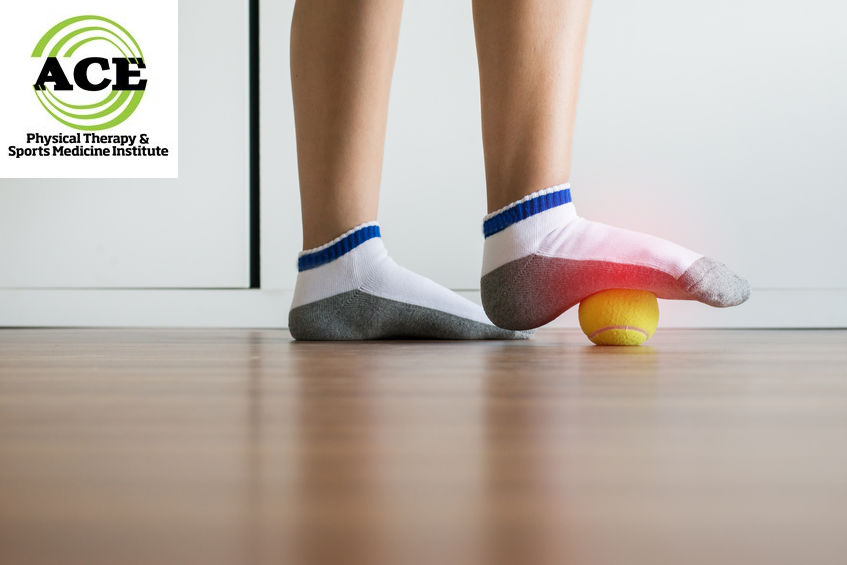WHAT IS THE BEST WAY TO TREAT HEEL PAIN: INJECTION OR CUSTOM ORTHOTIC

Tid Bits of Info
- The plantar fascia is the largest ligament in the body.
- Approximately 2 million people suffer from plantar fasciitis every year in the US.
- 10-20 % of all runners experience the symptoms of plantar fasciitis.
- Tight calf muscles can lead to plantar fasciitis.
- Seek the advice and treatment of a Physical Therapist if you have foot pain.
Heel pain can make it uncomfortable to do the simplest activities like walking, running, or playing sports. It may start out as a mild irritation, but over time it can get much worse. Patients have often been experiencing heel pain for several years before they seek help. There are several treatments or even a combination of treatments that can help reduce pain and prevent it in the future.
One reason people delay seeking help is that the pain is often intermittent. The symptoms may resolve or go dormant for a period of time, but something irritates the area and the pain returns. This on-again, off-again scenario usually stops the patient from seeking medical attention and formally treating the condition. When the pain finally becomes debilitating, the patient may have difficulty walking or doing common activities. This becomes the stimulus to seek formal medical treatment.
Heel pain can originate from many sources but most often it is associated with an irritation to the attachment of the plantar fascia on the calcaneus (heel bone). Another common cause as one ages can be due to a shrinking fat pad which is located on the bottom of the heel or a contusion to this area. There are less common causes of heel pain that involve some of the nerves that course through the ankle near the heel bone but these won’t be covered in this blog.
The most common type of heel pain is directly associated with the irritation of the plantar fascia at its attachment site on the calcaneus. The plantar fascia is a thick fibrous, leather-like structure that is located in the plantar aspect of the foot. Its primary job is to help support the arches of the foot. The plantar fascia can rupture if it goes untreated but it usually does not totally debilitate someone. The plantar fascia aides in locomotion by helping to make the foot rigid during the gait cycle. The plantar fascia becomes taut as the foot progresses through the cycle from mid stance to just prior to “toe off”. The taut fascia “pulls on the calcaneus and makes the arch very rigid. This rigidity enables the foot to support the body weight and when the toes move into a flexed (dorsi) position in preparation for “toe off” the tension within the fascia and stored energy due to the tension can be released and aide in propulsion.
There is a debate in the healthcare world on the best way to treat this condition. One quick fix to the symptom is to simply inject a corticosteroid into the irritated, inflamed plantar fascia. This has been shown to reduce the intensity of the pain significantly in a short period of time. Unfortunately, if this is the only treatment that is performed, there is a strong possibility that the symptoms will return within 6-8 weeks. A second approach is to assess the anatomy of the foot/feet and create a “custom” orthotic. This device helps to align the ankle/foot complex and control the motion that occurs when someone progresses through the gait cycle. This device is a custom made arch support created from specific measurements of their feet.
Studies indicate that using custom orthotics can reduce the symptoms of plantar heel pain over time. There is not an immediate reduction in pain in most instances, but the reduction usually lasts longer than an injection.
Ultimately, the resolution of these symptoms is usually dependent upon a combination of treatment protocols. Many times someone will require the injection, custom orthotics and participation in a thorough exercise routine that helps to stretch and strengthen the core and lower extremity musculature.

A Physical Therapists are licensed, healthcare professionals who evaluate your condition and design a thorough exercise routine that will include stretching and strengthening of the core and lower extremity musculature. The core is the foundation to all movement and the hip strength can help to reduce the amount of impact force and motion within the foot. The flexibility of the lower extremity and especially the calf muscles joints of the foot can limit the amount of strain on the plantar fascia. If there is adequate strength and flexibility within the lower extremity, the plantar fascia can usually “handle” the stress and strain that is placed on it during everyday life.
The most common cause of heel pain is associated with the irritation of the plantar fascia. Treatment protocols range from resting the area to aggressively treating it with injections, custom footwear and exercise. There is strong support for an aggressive approach to completely resolve the symptoms and correct the functional or anatomical “problems” that caused the condition in the first place.
























